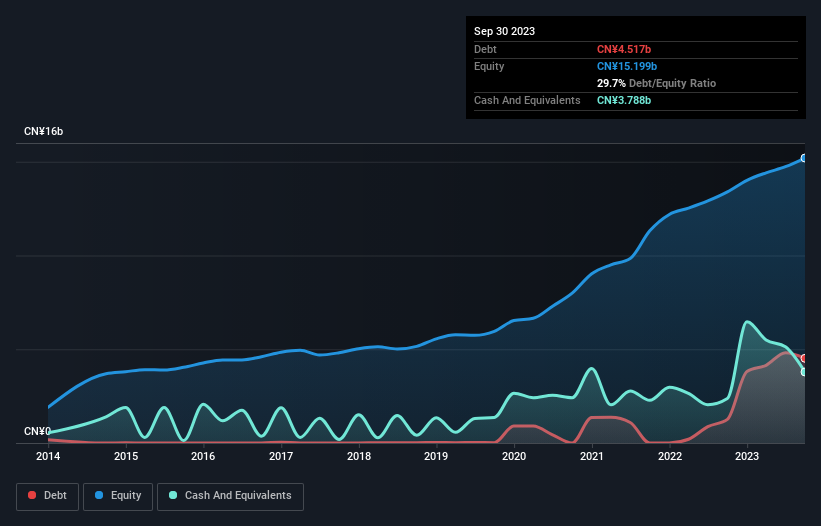- China
- /
- Semiconductors
- /
- SHSE:603806
Here's Why Hangzhou First Applied Material (SHSE:603806) Has A Meaningful Debt Burden

The external fund manager backed by Berkshire Hathaway's Charlie Munger, Li Lu, makes no bones about it when he says 'The biggest investment risk is not the volatility of prices, but whether you will suffer a permanent loss of capital.' It's only natural to consider a company's balance sheet when you examine how risky it is, since debt is often involved when a business collapses. We note that Hangzhou First Applied Material Co., Ltd. (SHSE:603806) does have debt on its balance sheet. But should shareholders be worried about its use of debt?
Why Does Debt Bring Risk?
Debt and other liabilities become risky for a business when it cannot easily fulfill those obligations, either with free cash flow or by raising capital at an attractive price. Part and parcel of capitalism is the process of 'creative destruction' where failed businesses are mercilessly liquidated by their bankers. However, a more usual (but still expensive) situation is where a company must dilute shareholders at a cheap share price simply to get debt under control. Having said that, the most common situation is where a company manages its debt reasonably well - and to its own advantage. The first step when considering a company's debt levels is to consider its cash and debt together.
Check out our latest analysis for Hangzhou First Applied Material
What Is Hangzhou First Applied Material's Net Debt?
You can click the graphic below for the historical numbers, but it shows that as of September 2023 Hangzhou First Applied Material had CN¥4.52b of debt, an increase on CN¥1.26b, over one year. However, it also had CN¥3.79b in cash, and so its net debt is CN¥729.0m.

A Look At Hangzhou First Applied Material's Liabilities
We can see from the most recent balance sheet that Hangzhou First Applied Material had liabilities of CN¥4.08b falling due within a year, and liabilities of CN¥2.67b due beyond that. Offsetting these obligations, it had cash of CN¥3.79b as well as receivables valued at CN¥8.99b due within 12 months. So it can boast CN¥6.03b more liquid assets than total liabilities.
This surplus suggests that Hangzhou First Applied Material has a conservative balance sheet, and could probably eliminate its debt without much difficulty. Carrying virtually no net debt, Hangzhou First Applied Material has a very light debt load indeed.
We use two main ratios to inform us about debt levels relative to earnings. The first is net debt divided by earnings before interest, tax, depreciation, and amortization (EBITDA), while the second is how many times its earnings before interest and tax (EBIT) covers its interest expense (or its interest cover, for short). This way, we consider both the absolute quantum of the debt, as well as the interest rates paid on it.
Hangzhou First Applied Material has net debt of just 0.40 times EBITDA, suggesting it could ramp leverage without breaking a sweat. But the really cool thing is that it actually managed to receive more interest than it paid, over the last year. So there's no doubt this company can take on debt while staying cool as a cucumber. It is just as well that Hangzhou First Applied Material's load is not too heavy, because its EBIT was down 41% over the last year. Falling earnings (if the trend continues) could eventually make even modest debt quite risky. The balance sheet is clearly the area to focus on when you are analysing debt. But it is future earnings, more than anything, that will determine Hangzhou First Applied Material's ability to maintain a healthy balance sheet going forward. So if you're focused on the future you can check out this free report showing analyst profit forecasts.
Finally, a business needs free cash flow to pay off debt; accounting profits just don't cut it. So it's worth checking how much of that EBIT is backed by free cash flow. During the last three years, Hangzhou First Applied Material burned a lot of cash. While investors are no doubt expecting a reversal of that situation in due course, it clearly does mean its use of debt is more risky.
Our View
We feel some trepidation about Hangzhou First Applied Material's difficulty EBIT growth rate, but we've got positives to focus on, too. For example, its interest cover and net debt to EBITDA give us some confidence in its ability to manage its debt. We think that Hangzhou First Applied Material's debt does make it a bit risky, after considering the aforementioned data points together. That's not necessarily a bad thing, since leverage can boost returns on equity, but it is something to be aware of. There's no doubt that we learn most about debt from the balance sheet. But ultimately, every company can contain risks that exist outside of the balance sheet. For instance, we've identified 2 warning signs for Hangzhou First Applied Material (1 shouldn't be ignored) you should be aware of.
If, after all that, you're more interested in a fast growing company with a rock-solid balance sheet, then check out our list of net cash growth stocks without delay.
Valuation is complex, but we're here to simplify it.
Discover if Hangzhou First Applied Material might be undervalued or overvalued with our detailed analysis, featuring fair value estimates, potential risks, dividends, insider trades, and its financial condition.
Access Free AnalysisHave feedback on this article? Concerned about the content? Get in touch with us directly. Alternatively, email editorial-team (at) simplywallst.com.
This article by Simply Wall St is general in nature. We provide commentary based on historical data and analyst forecasts only using an unbiased methodology and our articles are not intended to be financial advice. It does not constitute a recommendation to buy or sell any stock, and does not take account of your objectives, or your financial situation. We aim to bring you long-term focused analysis driven by fundamental data. Note that our analysis may not factor in the latest price-sensitive company announcements or qualitative material. Simply Wall St has no position in any stocks mentioned.
About SHSE:603806
Hangzhou First Applied Material
Designs, develops, manufactures, and sells solar battery encapsulation materials in China and internationally.
Excellent balance sheet average dividend payer.
Similar Companies
Market Insights
Community Narratives


